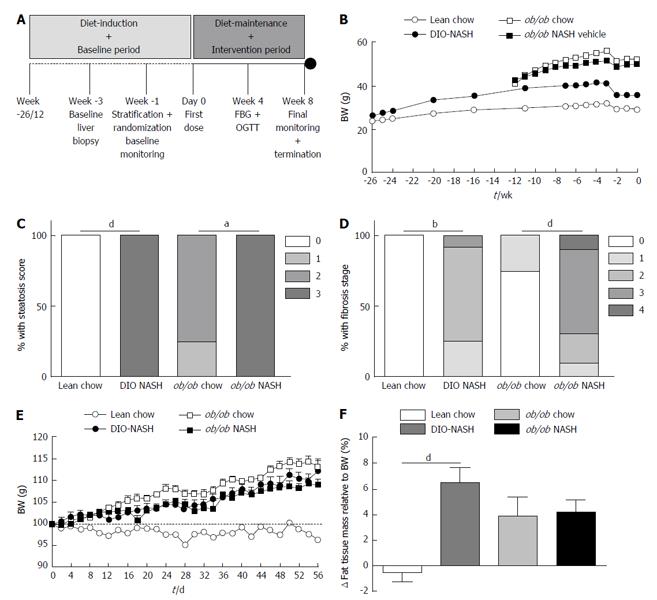Copyright
©The Author(s) 2016.
World J Hepatol. Jun 8, 2016; 8(16): 673-684
Published online Jun 8, 2016. doi: 10.4254/wjh.v8.i16.673
Published online Jun 8, 2016. doi: 10.4254/wjh.v8.i16.673
Figure 1 Study design, body weight regulation and liver biopsy-confirmed disease development.
A: Study design of the DIO-NASH and ob/ob NASH mouse models; B: BW during diet-induction and baseline period (monitoring and biopsy-recovery); C and D: Liver biopsy-derived histopathological assessment of (C) steatosis score (0-3), and (D) fibrosis stage (0-4); E and F: Change in BW (E), and change in adiposity (F), during diet-maintenance and intervention period (repeated vehicle dosing). aP < 0.05, bP < 0.01, dP < 0.001. The results are presented as mean ± SEM. Lean chow (n = 9), DIO-NASH (n = 12), ob/ob chow (n = 8), ob/ob NASH (n = 10). NASH: Nonalcoholic steatohepatitis; BW: Body weight; OGTT: Oral glucose tolerance test; FBG: Fed blood glucose; SEM: Standard error of the mean.
- Citation: Kristiansen MNB, Veidal SS, Rigbolt KTG, Tølbøl KS, Roth JD, Jelsing J, Vrang N, Feigh M. Obese diet-induced mouse models of nonalcoholic steatohepatitis-tracking disease by liver biopsy. World J Hepatol 2016; 8(16): 673-684
- URL: https://www.wjgnet.com/1948-5182/full/v8/i16/673.htm
- DOI: https://dx.doi.org/10.4254/wjh.v8.i16.673









